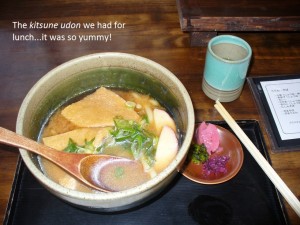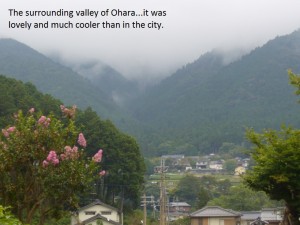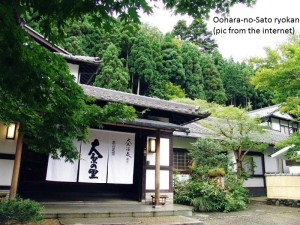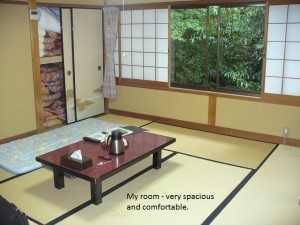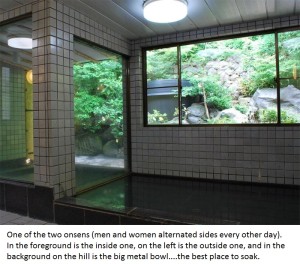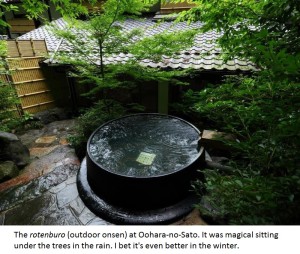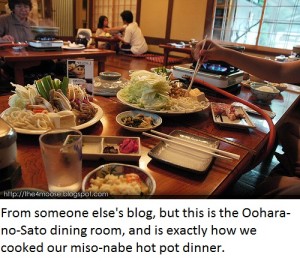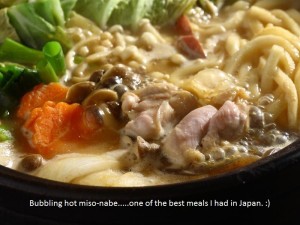
Day 7
For the next couple of days we were in Ohara. Ohara is a rural town around an hour’s ride north of central Kyoto, and is technically within Kyoto’s city limits, but in other ways a world away. It’s nestled in a valley between the Hira-san-kei Mountains to the east and the Kitayama Mountains to the west, and was just beautiful.
The trip didn’t start out very promising, as we got a cab driver who was brand new. Even though there was a sign over the highway (Ohara [arrow this way]) and I pointed it out to him, he still seemed confused. He had to call in to his dispatch and have a long conversation with them, and then called someone else (or maybe the same people) with his cell phone as well. He poured over a map he had, and Mil brought up another map on her phone to show him, but it didn’t seem to help much. Eventually we understood him to say that there were several Ohara’s, and I guess he didn’t know which one we meant. (And since we weren’t entirely sure which one we meant, we couldn’t help much!)
Eventually he got us there after a few false starts, and drove us right up to the door of the ryokan, Ohara-no-Sato. We arrived too early to check in, but they said we could leave our luggage while we went out to look for lunch. Fortunately there was a restaurant right across the (very tiny) lane, and though it was deserted they quickly prepared a lunch for us. And what a lunch! I ended up ordering a dish by mistake, but it turned out to be kitsune udon (the “fox udon” which I described in Day 4 of my report – the one with aburaage [thin slices of deep-fried tofu] on top of thick wheat noodles).
It was HEAVENLY. They’d somehow infused the tofu with miso, the traditional Japanese seasoning paste made from soybeans. It was a specialty of the area, rich and more sweet than salty. The aburaage was so flavorful, the noodles just right, the broth hot and satisfying. It was cool and wet outside, rain dripping off the Japanese maple tree leaves onto stone walkways, and just perfect sitting inside with this bowl of steaming udon.
After that fortifying lunch we took a short walk down the lane, checking out various other ryokans and shops. When it was time to check in we went back to the ryokan, where we were instructed to leave our shoes in a cubbyhole and put on one of the dozens of Japanese slip-on house slippers available for use. Because I still had socks on my feet (and the slippers had a plastic surface), I had trouble keeping them on. I managed by sort of shuffling along, but this was made more difficult by the fact that I had a heavy suitcase to carry. The suitcase had wheels, but I couldn’t wheel it all the way to the room because there were stairs involved.
And then more stairs.
And more stairs.
And after several more twisting passages, MORE STAIRS. It was never ending! Every time I turned a corner lugging my suitcase, there were more stairs to hoist that puppy up. Not to mention I was sliding out of the slippers as I was climbing, and could just imagine myself tumbling down at any second. My friend Mil managed not to laugh, which was fortunate. But I wished I had gone with my original plan, which was to send my suitcase on to Tokyo and just travel with my carry-on to the ryokan.
Eventually I got to my room, and it was really lovely. Tatami mat floors, a low table with hot tea on it, and sliding shoji window shades. The windows opened to a view of the trees, and you could hear a creek nearby trickling water. Birds were chirping and rain was still falling…..it was very serene.
This ryokan was modern and “self-service,” meaning we had to make our own beds from the futons which were in a closet behind another sliding shoji door. I piled up 4 futons and was very comfortable. In fact, it was softer than my mattress at the Toyoko Inn! There was also a small safe in the room and an electric fan, but it wasn’t needed.
Before dinner we decided to check out the onsen, which is a hot spring bath, and which at Oohara-no-Sato is supposed to come from the spring beneath their hotel and is a special ionized alkaline water. Being the typically modest type from Hawaii, I was unsure about visiting one at first. Though men and women are traditionally separated, you are supposed to bathe completely nude and can only carry a small washcloth with you. (I’d wondered to a co-worker what body part I’d be able to cover with that, and she replied, “Just cover your face!” *LOL*)
As it turned out, it was no problem. Mil and I were the only ones there at first, though a couple more women eventually joined us. You first have to sit on a small stool and completely wash yourself first, then climb into one of the 3 baths available. One was rectangular and indoors, the other was rectangular and right outside the door. The third was a big black pot which was up some steps and nestled under the trees. After soaking a bit in the first one, we made right for the big pot.
It was so beautiful! There was a slight drizzle, but the thickness of the tree cover overhead meant we didn’t really feel any raindrops. The water was very hot, but it was lovely to sit in the cool evening air and bask in the natural setting. Though you take your washcloth with you, it’s considered unhygienic and very bad manners to let it touch the bath water. Traditionally the Japanese fold it and rest it on their heads…probably to cool off. I didn’t do that but I did let it rest around my neck, especially when I was sitting on the side of the tub, also to cool off! I thought I would be able to soak for awhile because I love hot tubs, but the temperature in Japanese baths is much hotter – after a few minutes I found I needed to sit outside.
While we were there a woman named Hiroko joined us and started a conversation. It turned out Hiroko owned her own school that taught English to Japanese children, so of course her English was very good. She marveled that someone from Hawaii and someone from Australia had found their way to this little ryokan in the country. We told her it was due to the NHK television series about Venetia in Oohara (you can find videos on YouTube if you’re interested….her life is fascinating).
Dinner that night was a specialty of the house: miso nabe – a hotpot meal with a thick bubbling miso broth, into which we put chicken, and noodles, and all kinds of vegetables – carrots, Chinese (Napa) cabbage, green onions, shiitake and enoki mushrooms, bean sprouts, slices of round onion and sweet potato, cubes of tofu, and both udon and konnyaku (clear, from the root of a type of yam/potato) noodles. It was absolutely delicious, and I was so entranced with eating I forgot to take any photos, but fortunately I found some on the internet which I will include with this report.
Written by Suzette Tom
